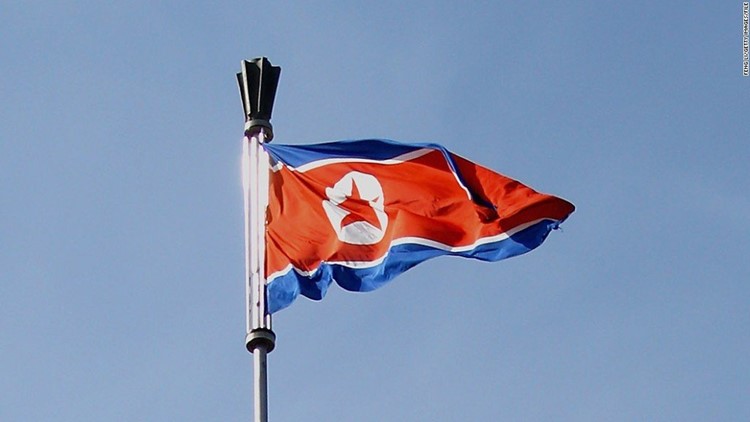PYONGYANG, North Korea — North Korea carried out a provocative new ballistic missile test early Sunday, sending a projectile to a higher altitude and closer to Russia than any of its recent tests, according to officials.
A missile launched near the city of Kusong, in western North Korea, flew across the country and into the Sea of Japan/East Sea, hitting the water about 60 miles from Vladivostok in eastern Russia, according to US officials.
Japan’s Defense Ministry said the missile reached an altitude of 2,000 kilometers (1,240 miles) and flew for 30 minutes.
“It is possibly a new type of missile,” Japanese Defense Minister Tomomi Inada said.
The high altitude and longer flight time indicate a missile with an extended range, according to David Wright, co-director of the Union of Concerned Scientists.
Writing on his organization’s blog, Wright pointed out that If the missile did reach that height and fly that long, it could reach the US territory of Guam in the Pacific.
Guam is home to Andersen Air Force Base, through which the US Air Force rotates heavy bombers including B-1s, B-2s and B-52s.
Russia responded to North Korea’s test by putting its far eastern air defenses on high alert, according to a report from the RIA-Novosti news agency.
“We cannot fail to understand that the territory of Russia is not only an object for attack but also a place where a missile may fall. In order to protect ourselves from possible incidents, we will keep our air defense systems in the Far East in a state of increased combat readiness,” Viktor Ozerov, head of the Federation Council Committee on Defense and Security, is quoted as saying.
Sunday’s test is the first from North Korea since South Korean President Moon Jae-in took office last week. Moon has advocated dialogue with North Korea to denuclearize.
Moon said the missile test violates UN Security Council resolutions and called it a severe challenge to the peace and security of the Korean Peninsula and the world, presidential spokesman Yoon Young-chan said.
South Korea needs to show the North that even though talks are possible, it will only be possible if North Korea changes its attitude, the President told staff.
He said South Korea will respond to provocations.
Messages from Pyongyang?
The direction of the missile, so close to Russia, was likely an attempt by North Korean leader Kim Jong Un to send a message to both Moscow and Beijing, said Carl Schuster, a Hawaii Pacific University professor and former director of operations at the US Pacific Command’s Joint Intelligence Center.
“It tells Russia, ‘I can touch you too,'” Schuster said.
“It tells China, ‘I don’t care what you think, I’m independent,'” he said.
China remains one of North Korea’s only allies and is responsible for much of the heavily-sanctioned nation’s economy.
On Sunday, Chinese leader Xi Jinping launched a major trade and infrastructure summit with multiple world leaders in Beijing. Russian President Vladimir Putin as well as a North Korean delegation attended the conference.
“The timing is not coincidental,” Schuster said, adding that Kim may be trying to get Putin more involved in the situation on the Korean Peninsula.
“It’s his way of telling the Russians, ‘You need to speak up,'” and stop US-supported international sanctions on North Korea, Schuster said.
The United States called for repercussions from the international community.
“With the missile impacting so close to Russian soil — in fact, closer to Russia than to Japan — the President cannot imagine that Russia is pleased,” the statement said.
“Let this latest provocation serve as a call for all nations to implement far stronger sanctions against North Korea,” White House press secretary Sean Spicer said in a statement.
China called for restraint by all parties.
“The current situation on the Korean Peninsula is complex and sensitive. All sides should exercise restraint and refrain from taking actions that would further escalate tensions in the region,” a statement from China’s Foreign Ministry said.
Japanese Prime Minister Shinzo Abe condemned the launch in a quick doorstep interview with reporters.
“Despite strong warning from the international community, North Korea launched a ballistic missile again,” Abe said. “This is totally unacceptable and we strongly protest it. North Korea’s missile launch is a serious threat to Japan and clearly violate against the UN resolution.”
Prior launches
The projectile launch comes two weeks after a ballistic missile test that South Korean and US officials said failed.
That missile, launched April 29, blew up over land in North Korean territory, according to a spokesman for the US Pacific Command.
Before Sunday, North Korea had attempted at least nine missile launches on six occasions since US President Donald Trump was inaugurated in January.
Though tensions between the United States and North Korea have been higher than usual over the past few months, a senior North Korean diplomat told South Korea’s Yonhap news agency on Saturday that Pyongyang is open to talks with Washington “under the right conditions.”
Earlier this month, Trump said he would be willing to meet North Korean leader Kim Jong Un “under the right circumstances.”
No sitting US president has ever met with the leader of North Korea while in power, and the idea is extremely controversial.
“North Korea has been a flagrant menace for far too long. South Korea and Japan have been watching this situation closely with us,” Spicer’s statement said.
Kim’s regime has sought to advance its nuclear and ballistic missile programs. The Trump administration has made a show of force in the region to deter those programs’ development.



